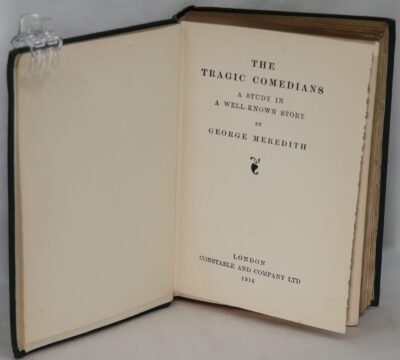The Hidden Order of Art.
By Anton Ehrenzweig
ISBN: 9780520038455
Printed: 1970
Publisher: Paladin. London
| Dimensions | 11 × 20 × 2 cm |
|---|---|
| Language |
Language: English
Size (cminches): 11 x 20 x 2
Condition: Fair (See explanation of ratings)
Item information
Description
Paperback. White title on the red and cream cover.
We provide an in-depth photographic presentation of this item to stimulate your feeling and touch. More traditional book descriptions are immediately available
-
This used book has a £3 discount when collected from our shop
For conditions, please view the photographs. From the Preface:The argument of this book ranges from highly theoretical speculations to highly topical problems of modern art and practical hints for the art teacher, and it is most unlikely that I can find a reader who will feel at home on every level of the argument. But fortunately this does not really matter. The principal ideas of the book can be understood even if the reader follows only one of the many lines of the discussion. The other aspects merely add stereoscopic depth to the argument, but not really new substance. May I, then, ask the reader not to be irritated by the obscurity of some of the material, to take out from the book what appeals to him and leave the rest unread? In a way this kind of reading needs what I will call a syncretistic approach. Children can listen breathlessly to a tale of which they understand only little. In the words of William James they take ‘flying leaps’ over long stretches that elude their understanding and fasten on the few points that appeal to them. They are still able to profit from this incomplete understanding. This ability of understanding- and it is an ability may be due to their syncretistic capacity to comprehend a total structure rather than analysing single elements. Child art too goes for the total structure without bothering about analytic details. I myself seem to have preserved some of this ability. This enables me to read technical books with some profit even if I am not conversant with some of the technical terms. A reader who cannot take ‘flying leaps’ over portions of technical information which he cannot understand will become of necessity a rather narrow specialist. It is an advantage therefore to retain some of the child’s syncretistic ability, in order to escape excessive specialization. This book is certainly not for the man who can digest his information only within a well-defined range of technical terms. A publisher’s reader once objected to my lack of focus. What he meant was that the argument had a tendency to jump from high psychological theory to highly practical recipes for art teaching and the like; scientific jargon mixed with mundane everyday language. This kind of treatment may well appear chaotic to an orderly mind. Yet I feel quite unrepentant. I realize that the apparently chaotic and scattered structure of my writing fits the subject matter of this book, which deals with the deceptive chaos in art’s vast substructure. There is a ‘hidden order’ in this chaos which only a properly attuned reader or art lover can grasp. All artistic structure is essentially ‘polyphonic’; it evolves not in a single line of thought, but in several superimposed strands at once. Hence creativity requires a diffuse, scattered kind of attention that contradicts our normal logical habits of thinking. Is it too high a claim to say that the polyphonic argument of my book must be read with this creative type of attention? I do not think that a reader who wants to proceed on a single track will understand the complexity of art and creativity in general anyway. So why bother about him? Even the most persuasive and logical argument cannot make up for his lack of sensitivity. On the other hand I have reason to hope that a reader who is attuned to the hidden substructure of art will find no difficulty in following the diffuse and scattered structure of my exposition. There is of course an intrinsic order in the progress of the book. Like most thinking on depth-psychology it proceeds from the conscious surface to the deeper levels of the unconscious. The first chapters deal with familiar technical and professional problems of the artist. Gradually aspects move into view that defy this kind of rational analysis.
Reviews:
-
“One of the most intelligent books ever written about the psychology of artistic creativity. . . . as relevant to the present situation of psychology as it is to the present situation of art.”–John Russell, The Sunday Times (London)
-
“In his remarkable study he has evolved an altogether new psychology of the artist and the art-work which accounts particularly for the development, significance, possibilities and limitations of modern abstract art.”–The Times Literary Supplement
-
“One of the most intelligent books ever written about the psychology of artistic creativity. . . . as relevant to the present situation of psychology as it is to the present situation of art.”–John Russell, The Sunday Times (London)
-
“In his remarkable study he has evolved an altogether new psychology of the artist and the art-work which accounts particularly for the development, significance, possibilities and limitations of modern abstract art.”–The Times Literary Supplement
-
Art theorist Anton Ehrenzweig’s understanding of creativity elaborates on how artists require a certain ego “dedifferentiation” as they submit to a certain influence of Thanatos – the death instinct followed by a reconstitution of their vision (by means of Eros): I have suggested that Thanatos, the death instinct, could be made responsible for the self-destructive effect of dedifferentiation a temporary decomposition of the (depth) ego; abstract thought can be seen as a success of Eros, the life instinct […] (Ehrenzweig 1967: 284). This psychological dynamic described above exemplifies the meaning of Nietzsche’s Zarathustra saying: “I love those who do not know how to live except their lives be a down-going, for they are those who are going across.” In other words, to create art involves a temporary sacrifice of the ego, as both Nietzsche and Ehrenzweig observed. The insights of the book are astounding.
Anton Ehrenzweig (27 November 1908 – 5 December 1966) was an Austrian-born British theorist on modern art and modern music. Ehrenzweig was born into an eminent Jewish legal family in Vienna with Czech and Galician roots. He was the son of Emma (née Bachrach) from Neuhaus in Southern Bohemia and Albert Rudolf Ehrenzweig, who was born in Vienna. His paternal grandfather and grandmother were from Lipník nad Bečvou (Leipnik) in Moravia and Lemberg, Galicia (now Lviv, Ukraine), respectively.
Want to know more about this item?

Related products
Share this Page with a friend











